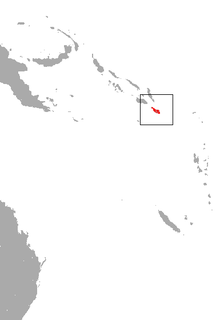
Felidae is a family of mammals in the order Carnivora, colloquially referred to as cats, and constitutes a clade. A member of this family is also called a felid. The term "cat" refers both to felids in general and specifically to the domestic cat.

The (IUCN) Red List of Threatened Species, founded in 1964, is the world's most comprehensive inventory of the global conservation status of biological species. It uses a set of criteria to evaluate the extinction risk of thousands of species and subspecies. These criteria are relevant to all species and all regions of the world. With its strong scientific base, the IUCN Red List is recognized as the most authoritative guide to the status of biological diversity. A series of Regional Red Lists are produced by countries or organizations, which assess the risk of extinction to species within a political management unit.

The Fijian mastiff bat is a species of bat in the family Molossidae. It is found in Fiji and Vanuatu. In 2013, Bat Conservation International listed this species as one of the 35 species of its worldwide priority list of conservation.

The Temotu flying fox is a species of flying fox in the family Pteropodidae. It is endemic to the Solomon Islands. It is threatened by habitat destruction due to subsistence agricultural practices, as well as natural disasters such as tropical cyclones. Due to its imperiled status, it is identified by the Alliance for Zero Extinction as a species in danger of imminent extinction. In 2013, Bat Conservation International listed this species as one of the 35 species of its worldwide priority list of conservation.
Hopea bilitonensis is a species of plant in the family Dipterocarpaceae. It is found in Indonesia and Malaysia.

The New Georgian monkey-faced bat is a recently described species of megabat endemic to the Solomon Islands, more specifically New Georgia and Vangunu Islands. It is presumably extinct on Kolombangara Island, and remaining population on other islands are threatened by habitat loss and hunting. Consequently, it is considered vulnerable by IUCN. In 2013, Bat Conservation International listed this species as one of the 35 species of its worldwide priority list of conservation.

Bat Conservation International (BCI) is an international nongovernmental organization working to conserve the world's bats and their habitats through conservation, education, and research efforts.

The Makira flying fox is a species of megabat in the genus Pteropus, found in the Solomon Islands. The species is currently decreasing and is endangered due to threats from logging and hunting. In 2013, Bat Conservation International listed this species as one of the 35 species of its worldwide priority list of conservation.

Blenniella is a genus of combtooth blennies found in the Pacific and Indian Oceans.
Blenniella caudolineata, the blue-spotted blenny, is a species of combtooth blenny found in coral reefs in the Pacific ocean.

Blenniella chrysospilos, the red-spotted blenny, is a species of combtooth blenny found in coral reefs in the Pacific and Indian oceans.

Blenniella cyanostigma, the striped rockskipper, is a species of combtooth blenny found in coral reefs in the Indian Ocean.

Blenniella gibbifrons, also known as the hump-headed blenny, bullethead rockskipper or picture rockskipper, is a species of combtooth blenny found in coral reefs in the Pacific and Indian Oceans from the East Africa to the Hawaiian, Line and Ducie Islands, north to Marcus Island.
Blenniella interrupta, the dashed-line blenny, is a species of combtooth blenny found in coral reefs in the western Pacific ocean.

Blenniella leopardus, the leopard blenniella , is a species of combtooth blenny found in the eastern Indian Ocean from Sumatra north to the Andaman Islands. It can reach a maximum length of 6 centimetres (2.4 in) SL.

Blenniella paula, the blue-dashed rockskipper, is a species of combtooth blenny found in coral reefs in the western Pacific ocean.

Blenniella periophthalmus is a species of combtooth blenny found in coral reefs in the Pacific and Indian oceans. It is commonly known as the blue-dashed rockskipper, bullethead rockskipper, false rockskipper, or the peppered blenny.

The World's 25 Most Endangered Primates is a list of highly endangered primate species selected and published by the International Union for Conservation of Nature Species Survival Commission Primate Specialist Group, the International Primatological Society (IPS), and Conservation International (CI). The 2012–2014 list added the Bristol Conservation and Science Foundation (BCSF) to the list of publishers. The IUCN/SSC PSG worked with CI to start the list in 2000, but in 2002, during the 19th Congress of the International Primatological Society, primatologists reviewed and debated the list, resulting in the 2002–2004 revision and the endorsement of the IPS. The publication has since been a joint project between the three conservation organizations and has been revised every two years following the biannual Congress of the IPS. Starting with the 2004–2006 report, the title changed to "Primates in Peril: The World's 25 Most Endangered Primates". That same year, the list began to provide information about each species, including their conservation status and the threats they face in the wild. The species text is written in collaboration with experts from the field, with 60 people contributing to the 2006–2008 report and 85 people contributing to the 2008–2010 report. The 2004–2006 and 2006–2008 reports were published in the IUCN/SSC PSG journal Primate Conservation, while the 2008–2010 and 2010-2012 report were published as independent publications by all three contributing organizations.
















